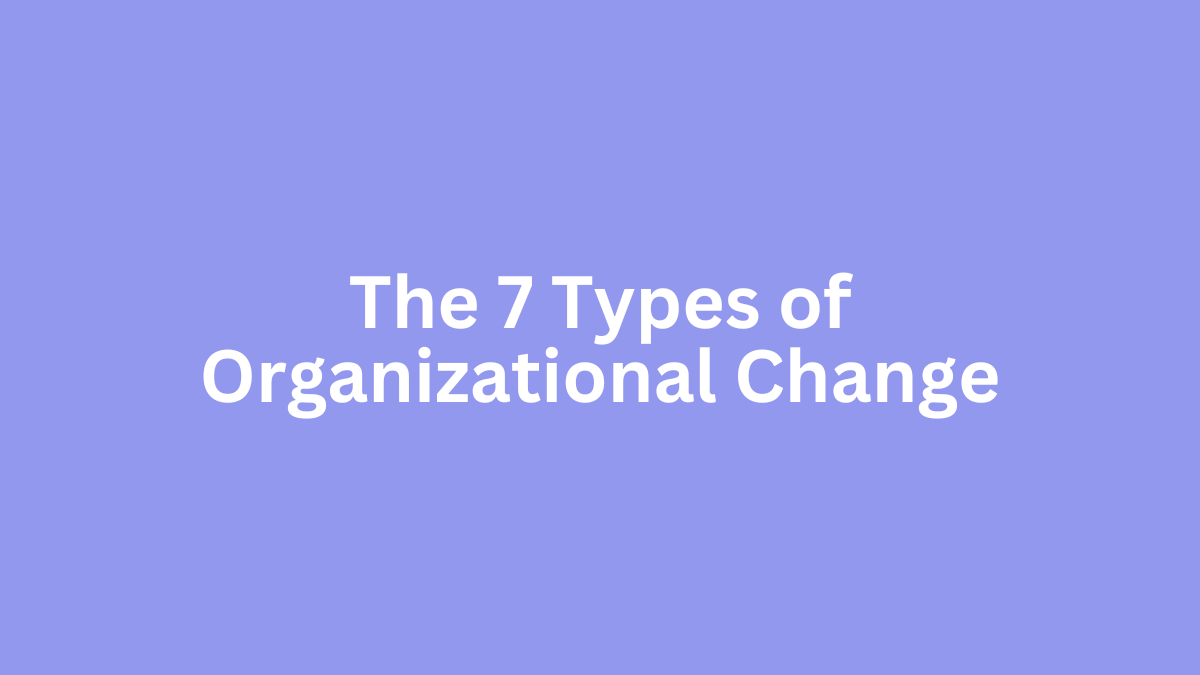Types of Organizational Change
Organizational change is a strategic approach to introduce change in the organizational working system to bring new systems and update its existing system to meet the new market trends.
There are different ways you can introduce change in the organization. Here, we will explore 7 major types of organizational change:
Strategic Change
Strategic change involves a deliberate alteration in the overall direction, goals, or mission of an organization. It is a proactive process often initiated by senior executives to adapt to external market conditions or internal challenges, requiring comprehensive planning and resource allocation for sustained success in a dynamic environment.
Pros:
- Enhanced Adaptability: Allows organizations to proactively respond to market dynamics, staying ahead of competitors.
- Improved Efficiency: Aligning strategies with current realities enhances operational efficiency.
- Long-term Sustainability: Strategic change positions the organization for sustained success in a dynamic environment.
Cons:
- Resistance: Employees and stakeholders may resist significant shifts in organizational direction.
- Implementation Challenges: Executing complex strategic changes may face hurdles, impacting timelines.
- Uncertainty: The uncertainty inherent in strategic changes can lead to anxiety among employees.
People-Centric Change
People-centric change focuses on the human elements affected by organizational shifts, considering the impact on employees, customers, and stakeholders. It emphasizes the human element, considering the emotions and motivations of employees, customers, and stakeholders during organizational transitions.
This approach aims to build engagement, collaboration, and satisfaction, recognizing that a positive internal culture contributes to overall success and adaptability.
Pros:
- Increased Morale: Prioritizing people’s well-being boosts morale and fosters a positive work environment.
- Higher Productivity: Engaged employees are more likely to be productive and contribute creatively.
- Enhanced Adaptability: When people understand and buy into the change, adaptation is smoother.
Cons:
- Time-Consuming: Addressing individual needs and concerns may extend the implementation timeline.
- Resistance: Despite efforts, some individuals may resist change, affecting overall effectiveness.
- Resource Intensive: Requires substantial resources for communication, training, and support.
Structural Change
Structural change involves altering the organizational hierarchy, roles, or reporting relationships. It may include reorganization, mergers, acquisitions, or leadership changes.
Pros:
- Improved Efficiency: Restructuring can eliminate redundancies and streamline processes.
- Clearer Accountability: Clearly defined roles enhance accountability and responsibility.
- Better Alignment: Aligning structure with organizational goals improves overall effectiveness.
Cons:
- Employee Disruption: Changes in structure may cause uncertainty and disrupt day-to-day operations.
- Resistance: Employees may resist changes to familiar reporting structures or job roles.
- Cultural Impact: Structural changes can impact organizational culture, requiring careful management.
Technological Change
Technological organizational change involves the integration of new technologies, software, or systems into the organization’s operations. It aims to enhance efficiency, innovation, and competitiveness.
Pros:
- Increased Efficiency: Technology often automates tasks, reducing manual effort and errors.
- Innovation: Adopting new technologies fosters innovation and keeps the organization competitive.
- Data-driven Decision-Making: Technological tools provide valuable data for informed decision-making.
Cons:
- Resistance: Employees may resist adapting to new technologies, affecting implementation.
- Initial Costs: Implementing new technology involves upfront costs and potential disruptions.
- Learning Curve: Staff may require time to learn and adapt to new technological tools.
Read More: What is Deming Management?
Unplanned Change
Unplanned change results from unforeseen events or crises, requiring immediate response to address challenges and stabilize the organization.
Pros:
- Crisis Resolution: Unplanned changes allow quick response to crises, minimizing damage.
- Adaptive Capacity: Organizations that effectively manage unplanned changes showcase adaptability.
- Learning Opportunities: Unplanned changes provide lessons for future crisis management.
Cons:
- Disruption: Sudden changes can disrupt normal operations, causing short-term chaos.
- Lack of Preparation: Organizations may be ill-prepared to handle unexpected challenges.
- Employee Anxiety: Uncertainty during unplanned changes may lead to increased employee stress.
Transformational Change
Transformational change involves a radical shift in the organization’s identity, culture, and processes. It goes beyond incremental adjustments, aiming for a fundamental and often disruptive transformation.
Pros:
- Market Leadership: Successful transformation can position the organization as an industry leader.
- Adaptation to Trends: Enables organizations to adapt to changing market trends effectively.
- Innovation: Transformation often fosters a culture of innovation and continuous improvement.
Read More: The 4 Major Areas of Organizational Change
Cons:
- Resistance: Drastic changes can face significant resistance from employees and stakeholders.
- Uncertainty: The unpredictable nature of transformational change may create uncertainty.
- Resource Intensive: Implementation requires significant resources and commitment.
Remedial Change
Remedial change is adopted to rectify a bad situation or performance. It involves corrective actions management takes to address issues affecting the organization negatively.
Pros:
- Crisis Resolution: Remedial change aims to address and resolve specific issues promptly.
- Improved Performance: Corrective actions can lead to improved organizational performance.
- Learning from Mistakes: Remedial change provides an opportunity to learn from past mistakes.
Cons:
- Employee Morale: The need for remedial change may impact employee morale negatively.
- Time Sensitivity: Swift action is often required, limiting the time available for thorough planning.
- Potential Resistance: Employees may resist changes implemented to address shortcomings.
Hence, these are the 7 types of organizational change explained with their pros and cons.
Read Next: Types of Control

Sujan Chaudhary holds a Bachelor in Business Administration (BBA) degree and is currently pursuing an MBA degree. He loves to share his business knowledge with the rest of the world.
